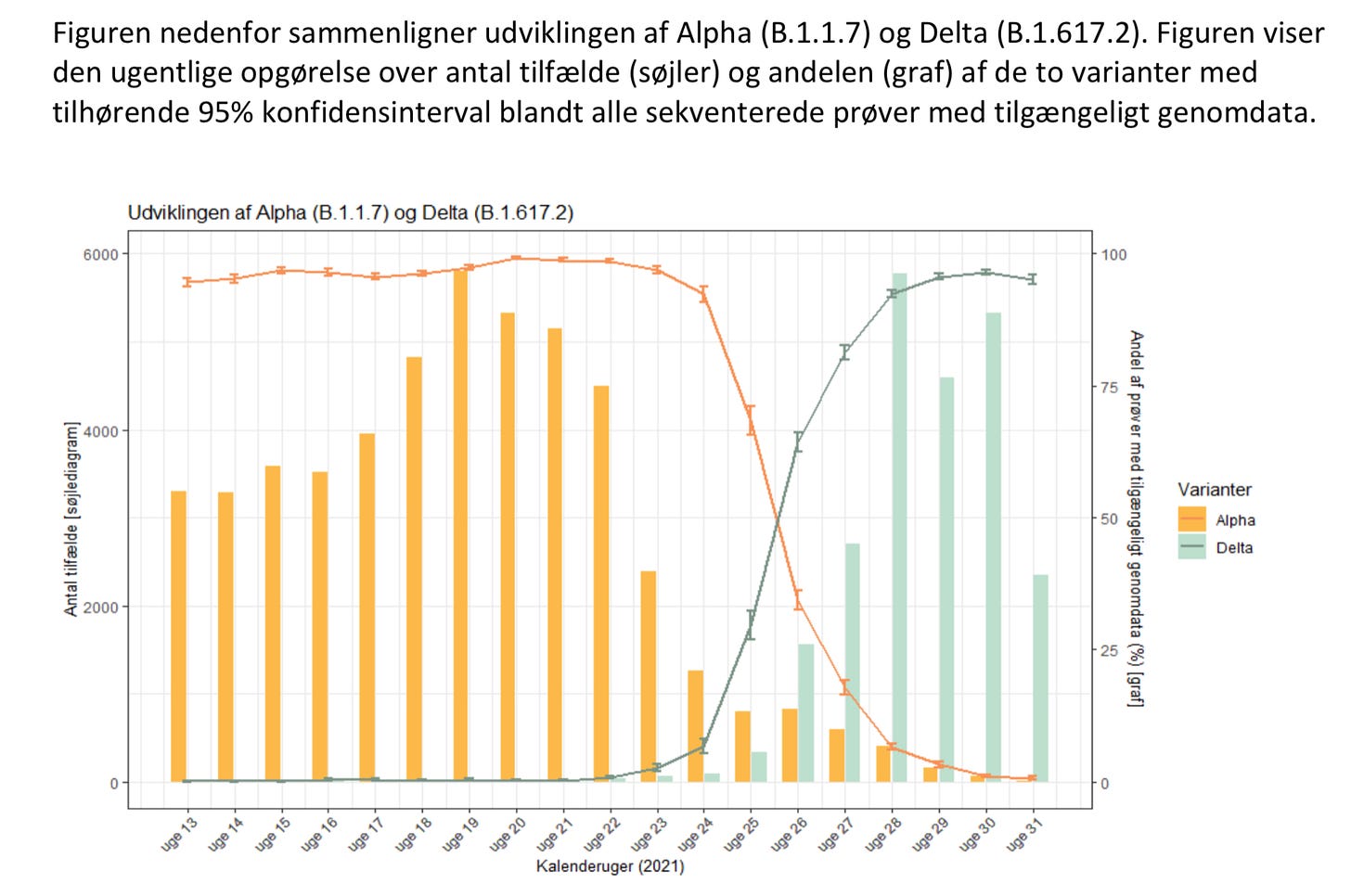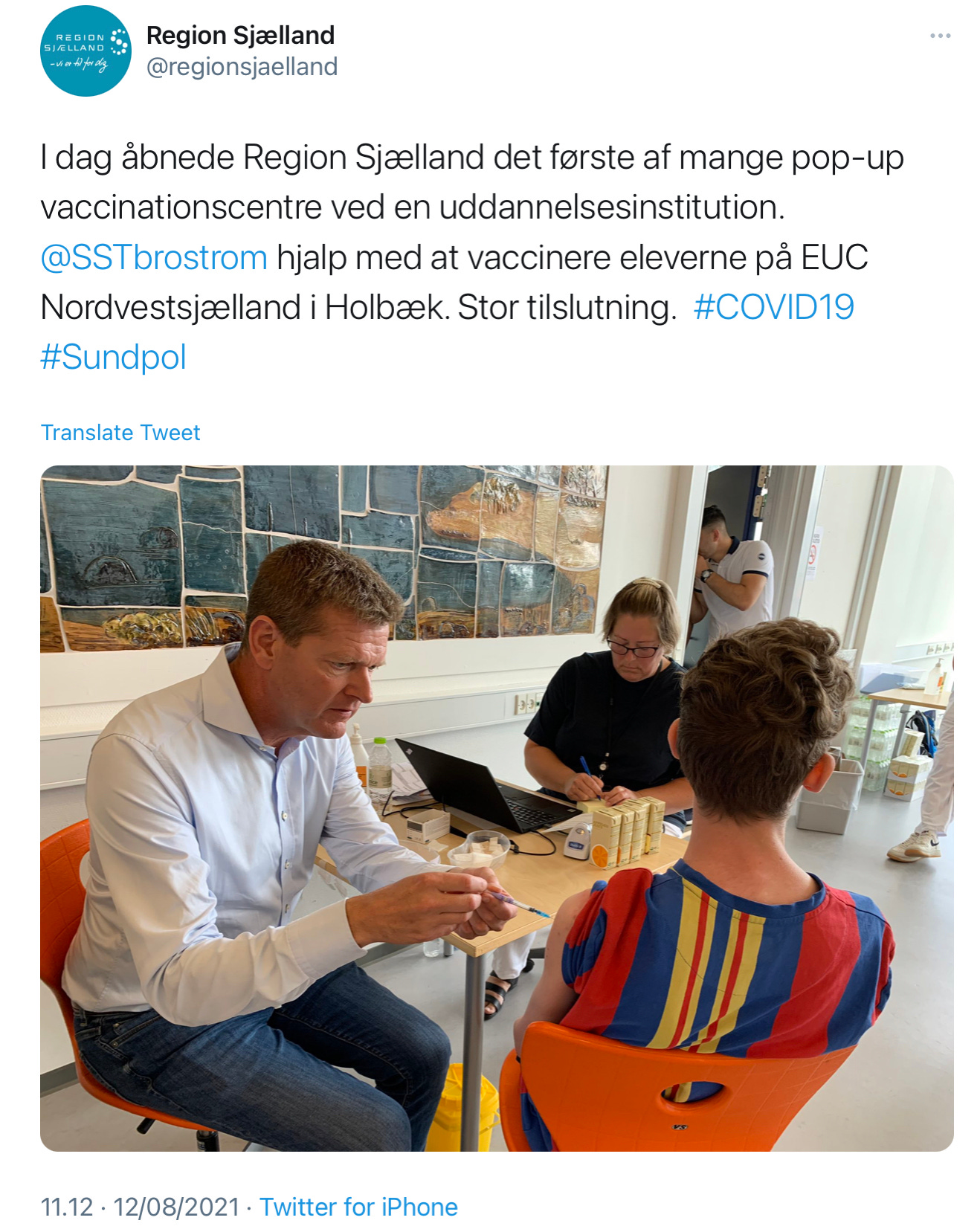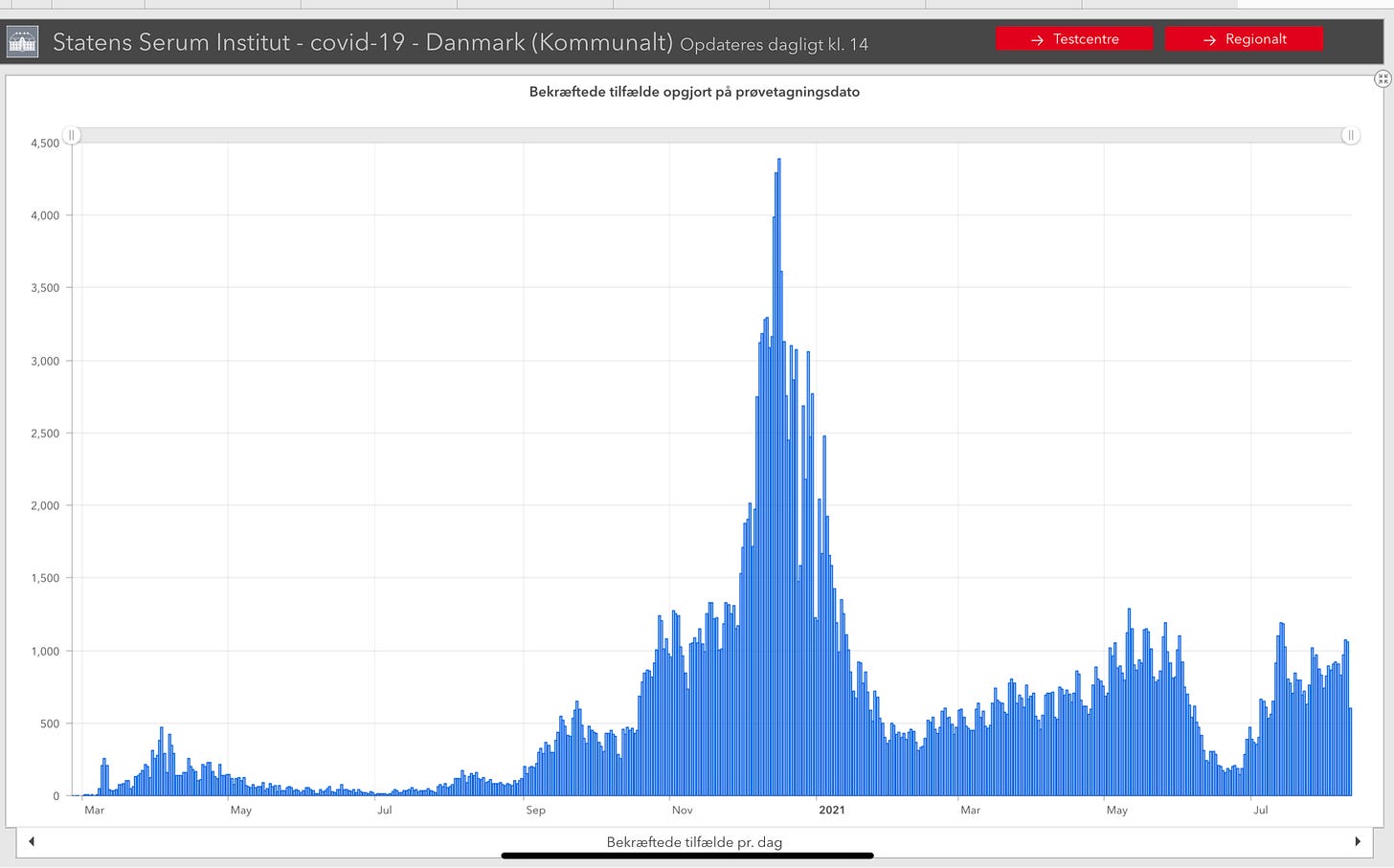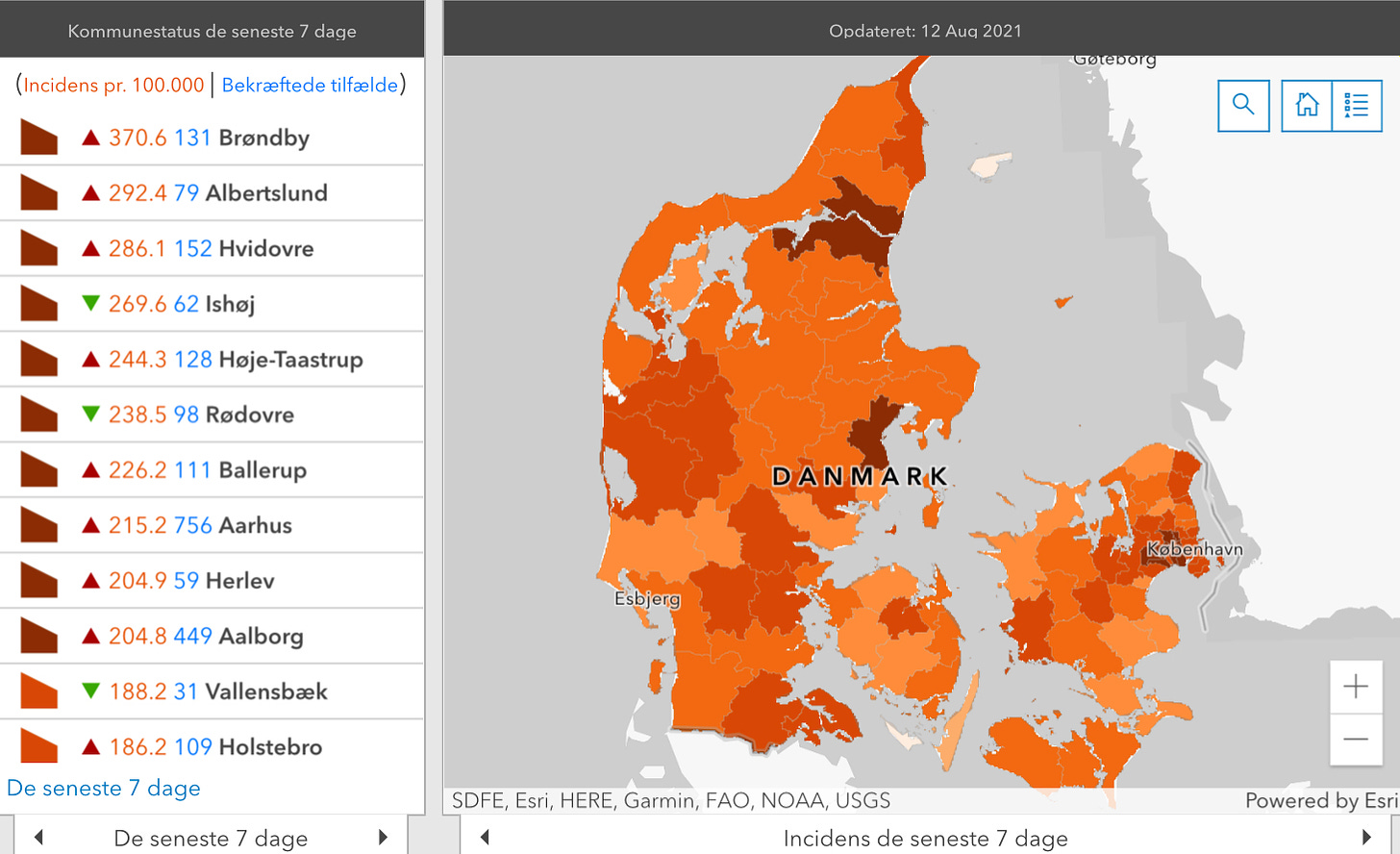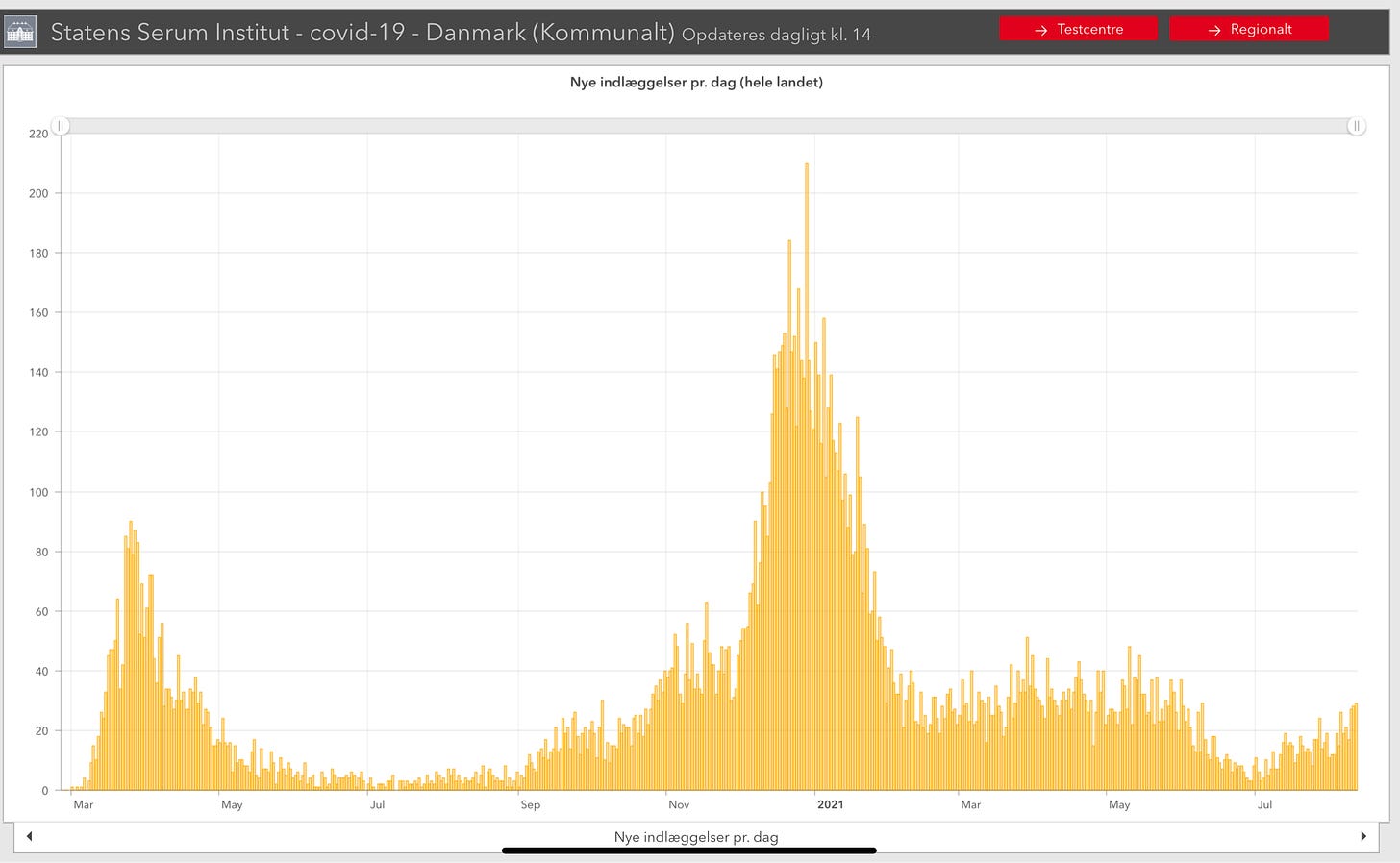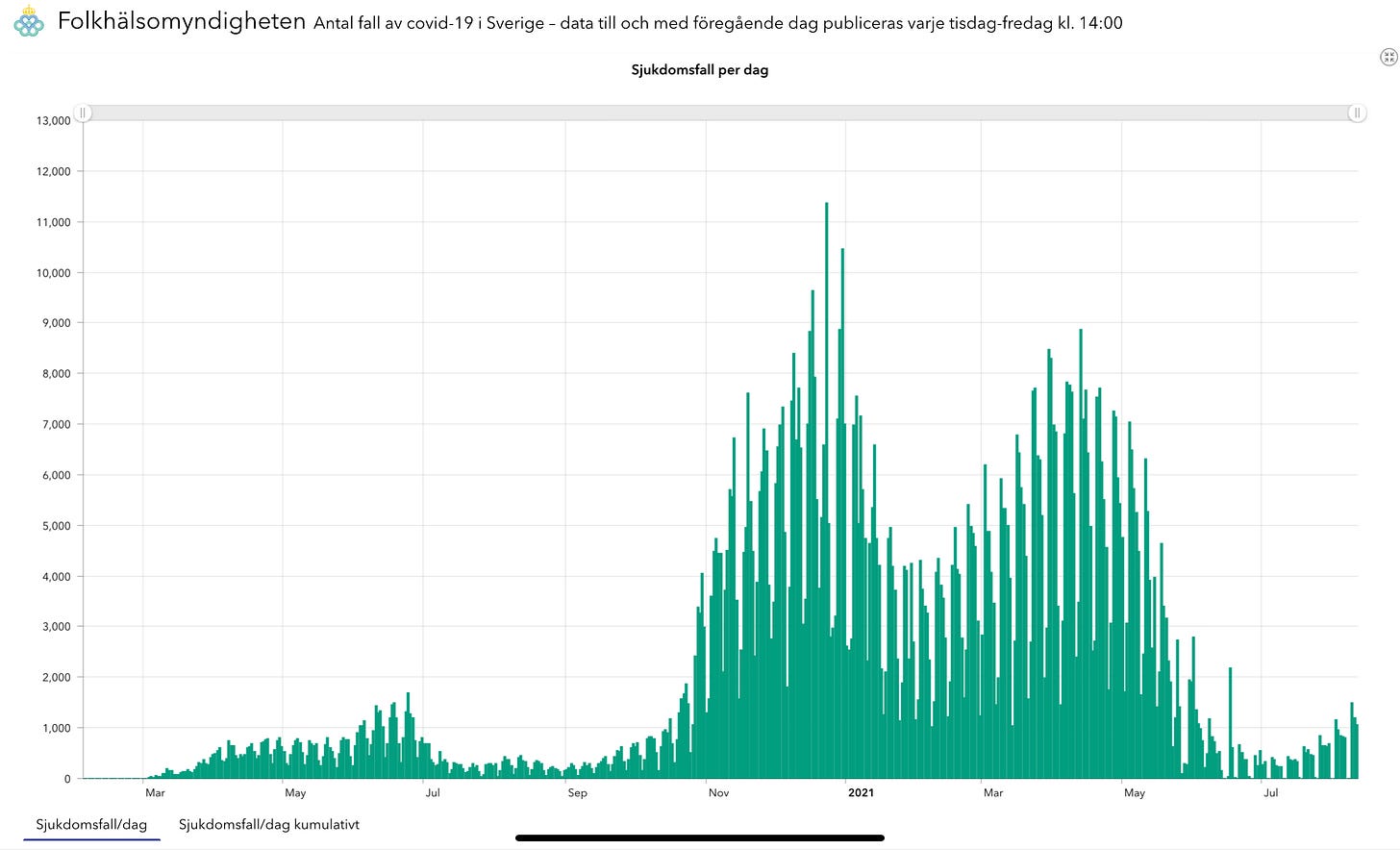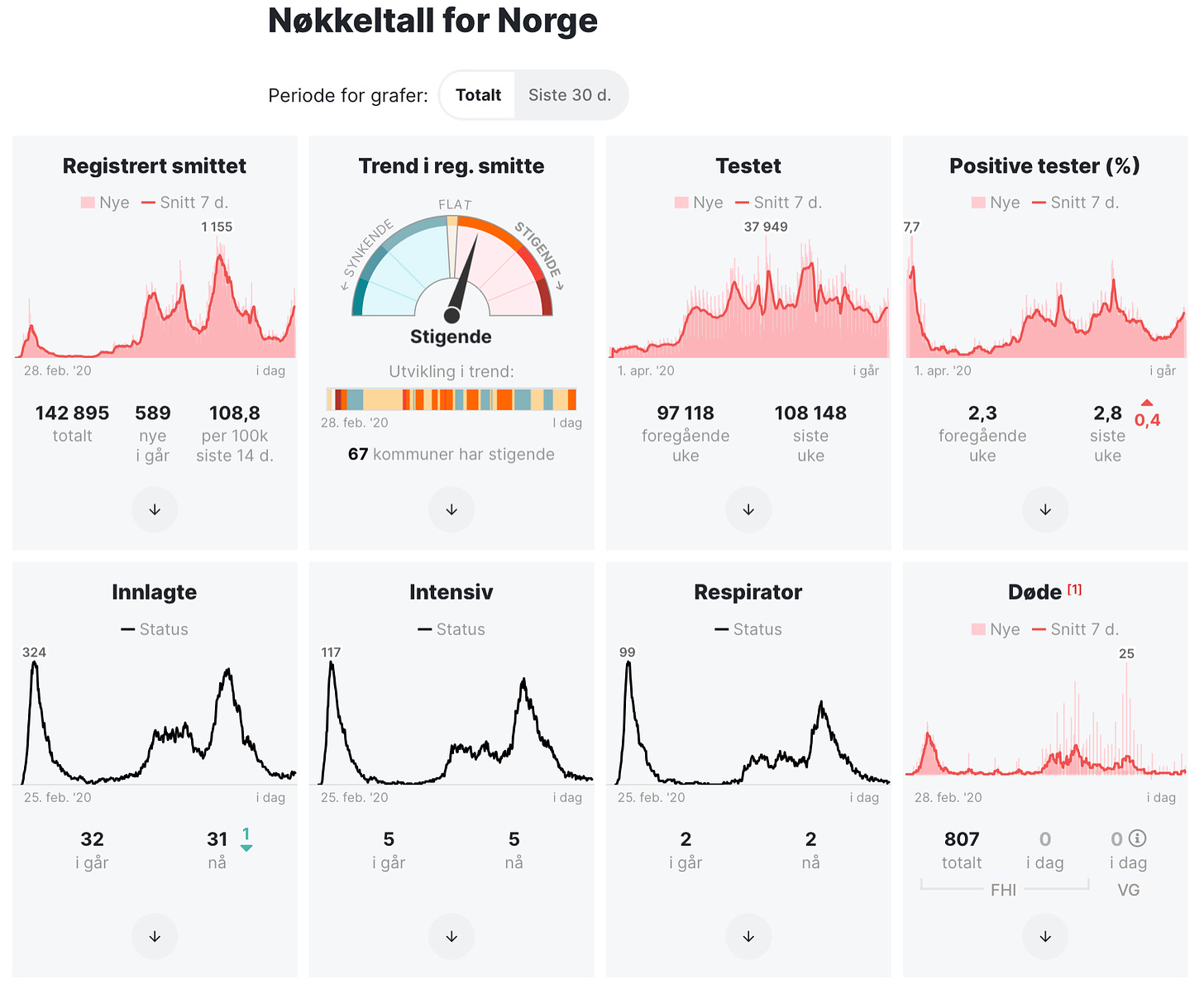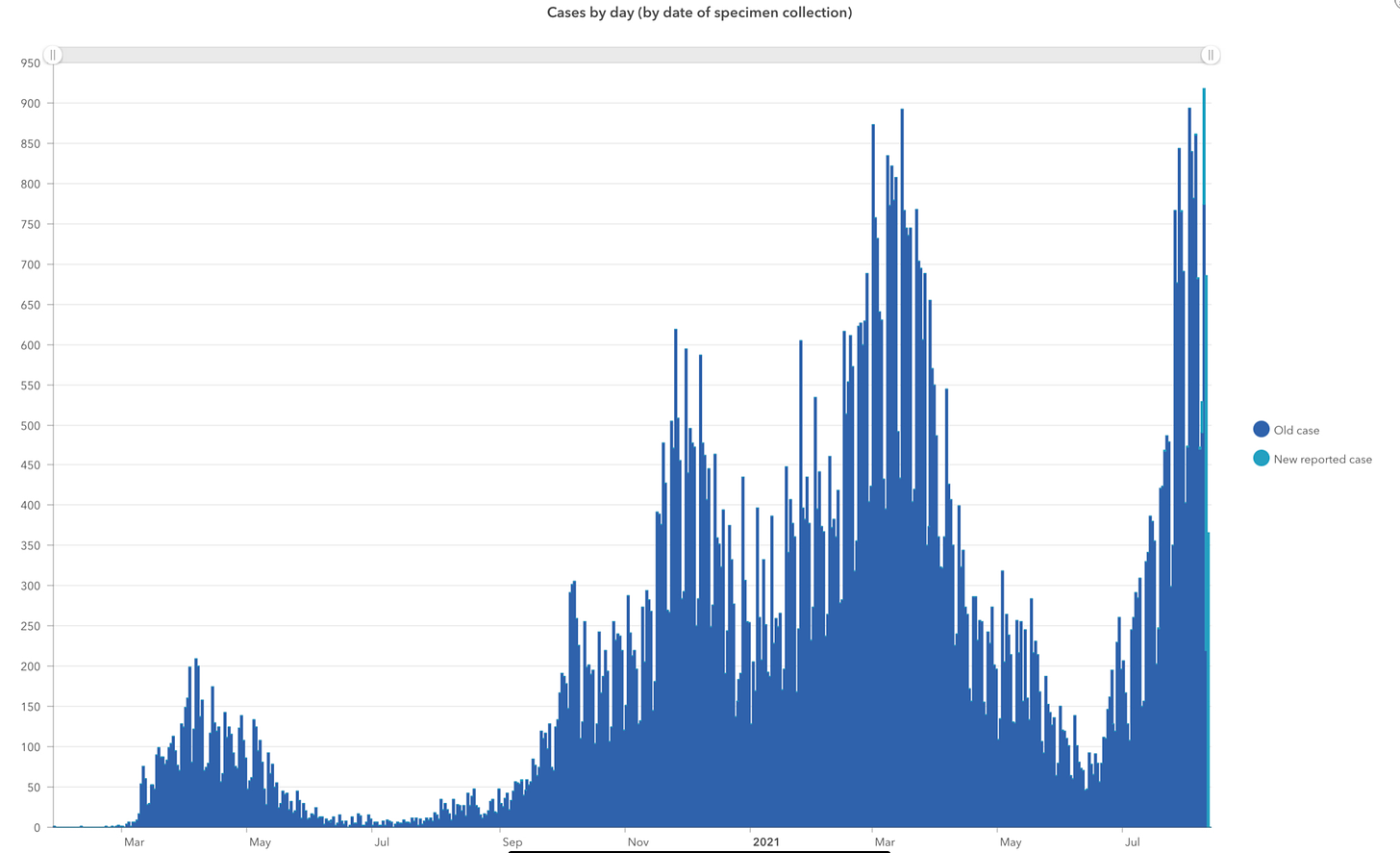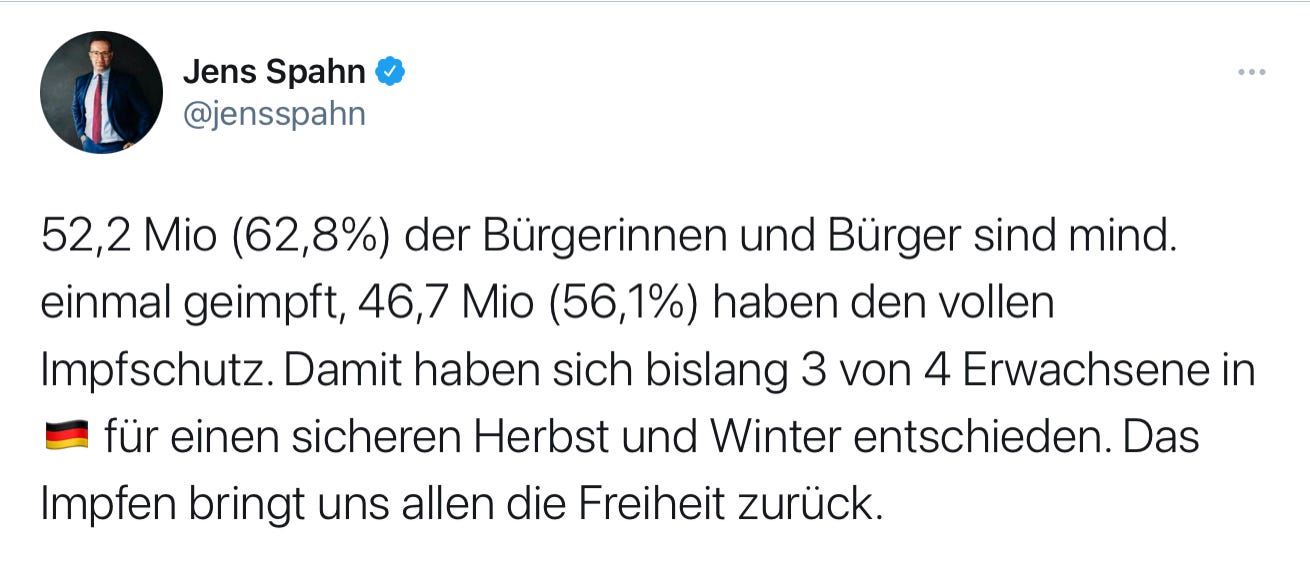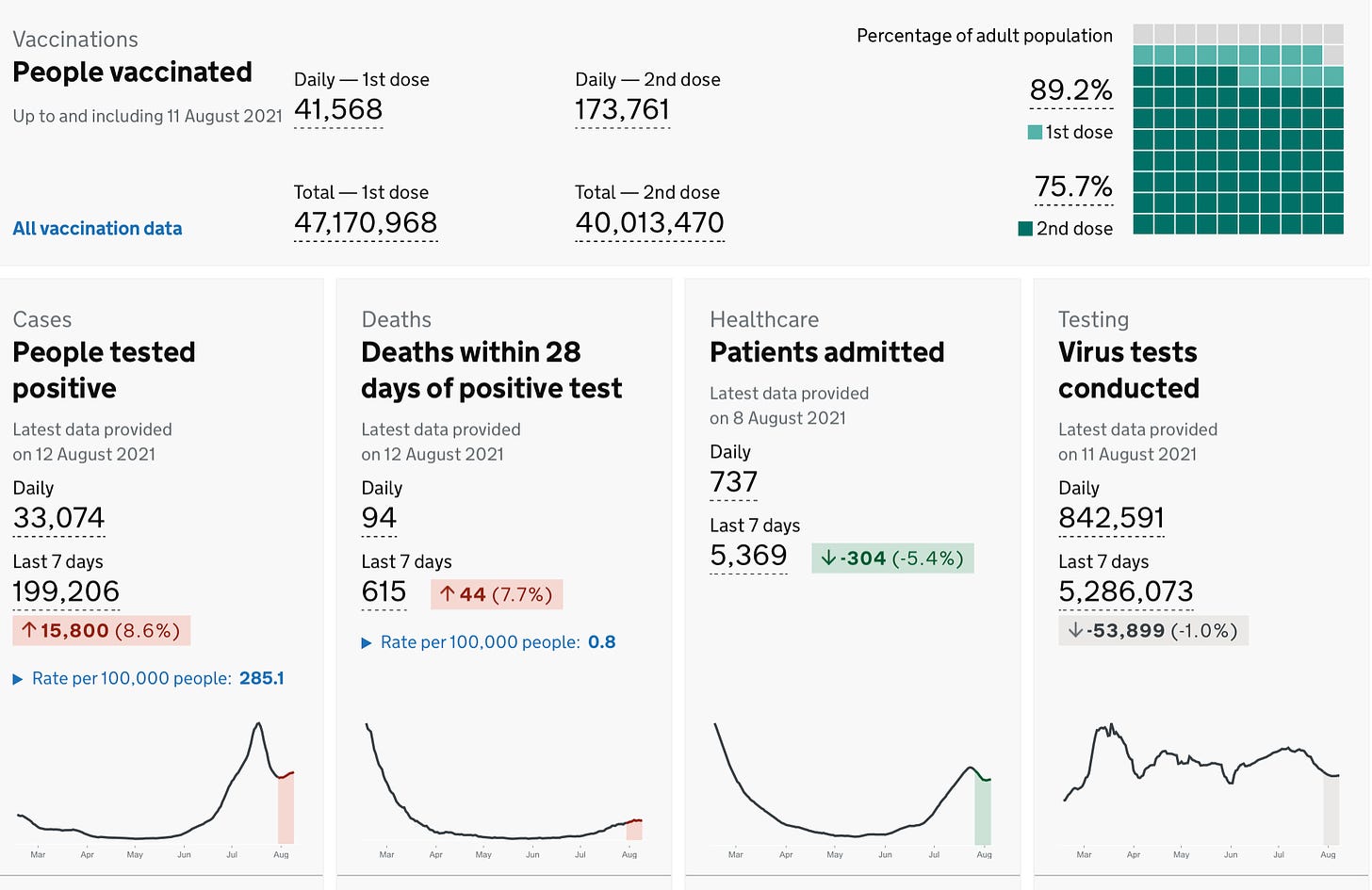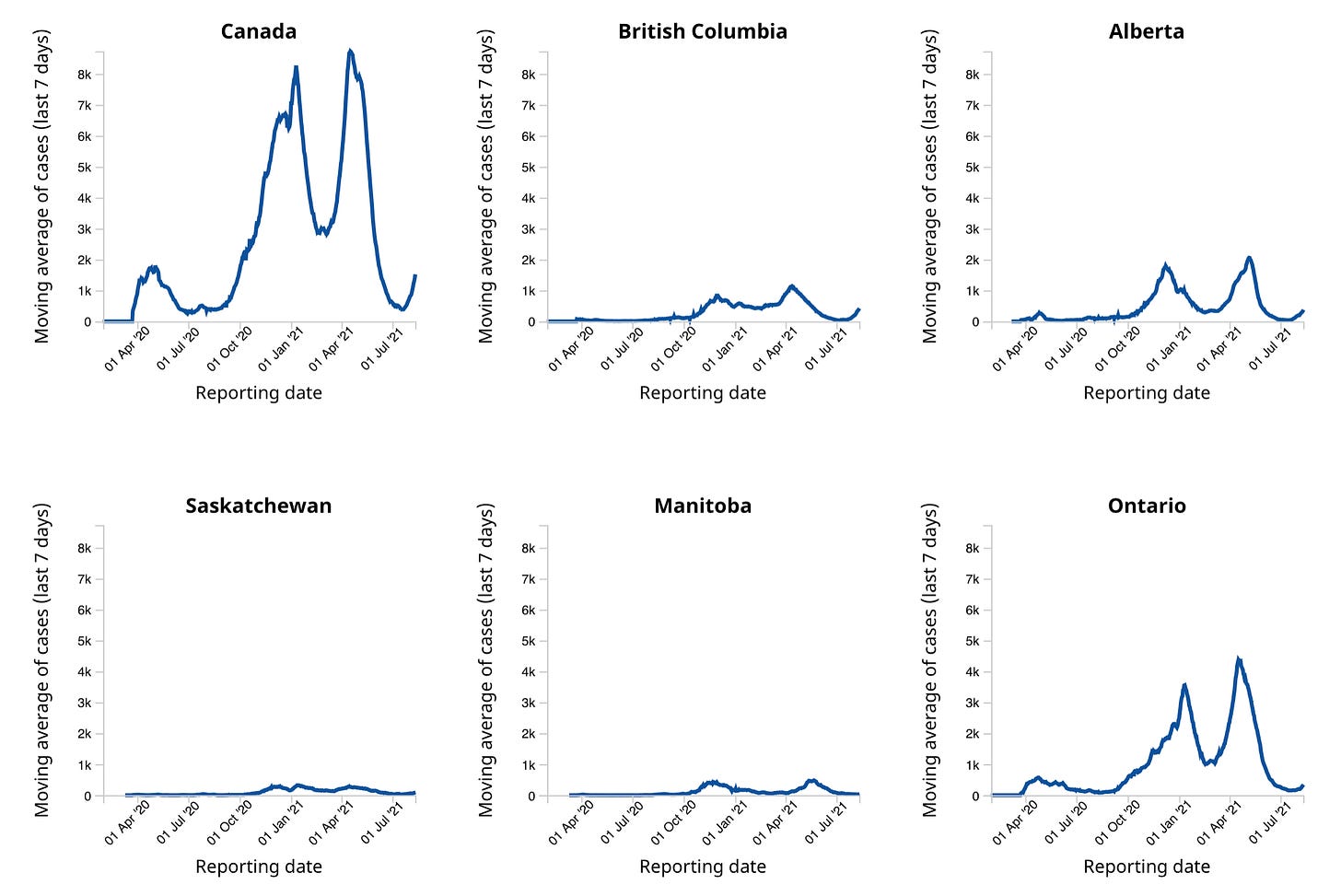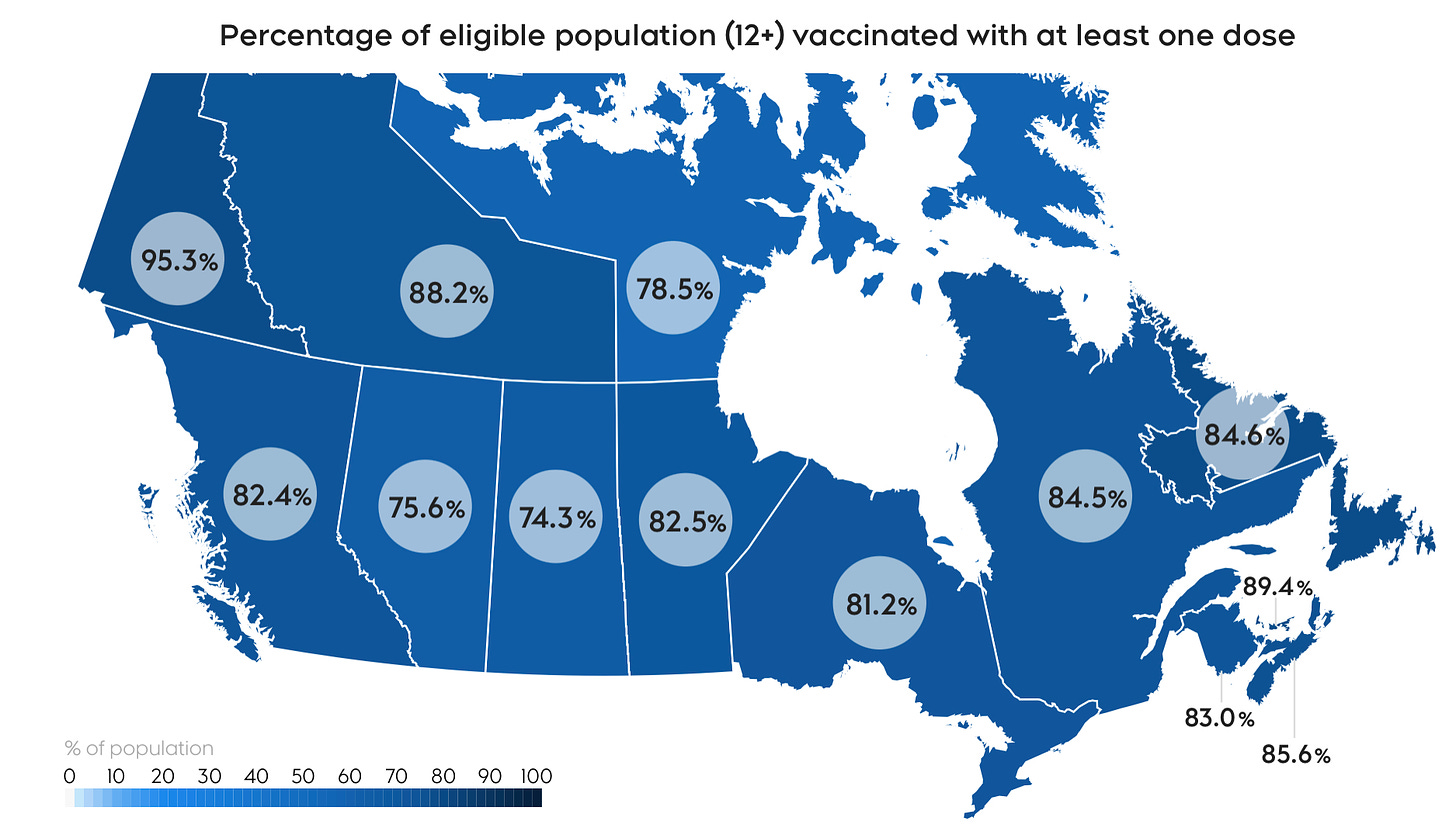The Evening Report - Aug 12
Young adults in Denmark have the lowest vaccinations rates and most infections
🇩🇰
The Delta variant is now so dominant in Denmark that there has not been a single case of any other variant in the country over the last seven days. However, over the same time period, there has been another 6,268 confirmed cases of the much more infectious Delta variant, pushing the total to-date number of variant cases to 22,957.
You can see in the chart below from the Staten Serum Institut that the Delta variant has driven the Alpha variant to all but vanish.
-
The Danish National Health Board says vaccinations rates among those aged 20 to 29 years old are lagging behind every other age group. The health board said it’ll now launch a national campaign aimed at amping up vaccinations in this age group.
Director Søren Brostrøm:
“There can be many explanations for why they have not been vaccinated yet. Some may have been away on summer vacation. There has also been a high level of infection in this particular group, and therefore some of them have had a valid coronapas because they have been previously infected. Some people probably also do not know that it is important to be vaccinated, even if you have been infected, or that you can be infected with coronavirus several times. Others may just not have booked time. That is why we are putting in extra effort with a campaign that reminds young people to be vaccinated.”
Brostrøm says the much more infectious Delta variant poses a more serious risk even for those who are younger.
“Young people can also get severe illnesses with fever, fatigue and lose their sense of taste and smell. Some will be affected by long-COVID for months after. And we must not forget that an infection can send young people home in isolation, and that they then miss parties, socializing with their peers, and school. Some also risk infecting their friends and family, and very few people want that.”
As part of the outreach effort to young adults Brostrøm was out helping to inoculate students at a pop-up vaccination site at EUC Nordvestsjælland in Holbæk.
-
Denmark has signed on to the EU agreement for 20 million doses of the Novavax COVID vaccine. It means of the 20 million doses, 280,000 will flow to Denmark once the vaccine is approved for use in Europe.
Health Minister Magnus Heunicke:
“Although the vaccine rollout in Denmark is now going really well, it is important that we continue to follow the development of new vaccines closely. Corona is still in our society, and in the long run there may be a need to incorporate vaccine technologies other than those on which Pfizer and Moderna are based.”
Novavax, which has had some very promising results from clinical trials, is currently under a rolling review by the European Medicines Agency.
-
Denmark has reported 1,085 COVID infections and one new coronavirus death in the last day. This marks the third straight day where daily infections have been in excess of 1,000.
Yesterday, there were 135,616 total corona tests done, 57,072 PCR and 78,544 rapid, for a (PCR only) positivity percentage of 1.90%, which remains very high.
There are now 40 Danish kommunes with COVID incidence rates above 100 per 100,000 residents. Of those, nine have an incidence rate above 200. In Brønby, the coronavirus incidence rate has rocketed up to 370.
-
COVID hospitalizations (113) continues to climb (+10) reaching levels today not seen in two months, while the number of infected people in an ICU (16) declined slightly (-2) and of those, the number on a ventilator (12) was unchanged.
-
The Danish National Health Board has removed a fixed social distancing requirement to keep two meters away from others when out in the public. The national health agency has replaced the fixed distance with the advice “keep distance from others in public spaces where possible.”
The changes also mean hugs, kisses, and handshakes among friends and family members provided, they too are vaccinated, are okay again.
Deputy Director Helene Bilsted Probst:
“We are now a place where we have good control of the infection in the community because there are so many who have accepted the offer to be vaccinated. Therefore, we can adapt the prevention recommendations so that you can both maintain a normal everyday life, while at the same time insisting that we must prevent infection. There is still coronavirus in society, so we must continue to be aware of disease. But if we do, then there is also the opportunity to gradually approach the everyday life that we know from before COVID, and which many have missed.”
The National Health is encouraging everyone to get vaccinated and observe six general recommendations to safeguard themselves from the coronavirus and “other infectious diseases that circulate, especially in the autumn and winter seasons such as the flu.”
The National Board of Health's six general tips for infection prevention are:
Get vaccinated
Stay home and get tested if you get symptoms
Keep distance
Ventilate and create draft
Wash your hands often or use rubbing alcohol
Clean, especially surfaces that many touch
🇸🇪
Sweden has added 1,055 infections and had no new corona deaths since yesterday’s update.
To date, 6,608,479 1st doses (80.7% of the population over the age of 18) and 4,714,651 2nd vaccine doses (57.6%) have been administered.
-
The Swedish Government might delay its next phase of reopening scheduled for next month. It has proposed to extend legislation governing COVID restrictions until at least the end of January of next year. This would extend all restrictions and temporary control measures for four months.
In a press conference today, Minister of Social Affairs Lena Hallengren says this could mean the next phase of reopening might be postponed.
“Right now we have a situation with low death rates, but we also see that the spread of infection is increasing. We will follow the development for some time to come and we promise to let you know in good time.”
The extension applies to two acts that give the Swedish Government powers to impose restrictions and binding measures to try and curtail any infection increases. In proposing to extend the two bills, the government states “The COVID pandemic is still ongoing. Based on the knowledge that the infection situation may change or worsen, the Government is concerned that Sweden continues to be well-prepared to be able to put in place accurate measures to combat COVID.”
Sweden has a five-phase plan to lift COVID restrictions, with the fourth phase supposed to take place in September.
-
The Swedish Public Health Agency has tabled guidelines to try and contain coronavirus infections in schools as students head back to class. The agency, while young people rarely ever suffer serious cases of COVID, the Delta variant has changed the game.
Department Head Britta Björkholm:
“In person learning is the best teaching method for most children and young people and plays an important role in their health and opportunities later in life. Children's right to a good education and social development need to be maintained during the COVID pandemic.”
The agency says the Swedish regions and school staff must be prepared for any infections or full-blown outbreaks, should they occur. It has also advised schools to take preventive measures.
Municipalities and regions should continue to keep testing capacity and contact tracing at high levels with students in mind.
Avoid crowded classrooms or student gatherings
While the weather is good teachers should move classrooms outside
Any staff meetings should also be done either online or outside
Communicate Public Health Agency general guidelines to all students, parents, and staff
Anyone who has symptoms must stay home
Maintain good hand hygiene with lots of hand-washing
Masks aren’t mentioned in the guidelines, but Sara Byfors, the Public Health Agency Unit Manager, was asked why masks were not in play by Swedish media outlet SVT.
“It is quite difficult to wear a mask during an entire school day, we do not see it as an effective measure in this environment.”
🇳🇴
Norway has added 574 infections and had no new virus deaths since yesterday’s update.
COVID hospitalizations (31) inched down (-1) while those in ICU numbers (5) and on a ventilator (2) are both unchanged.
So far, 69.40% of Norwegians have had one vaccine dose and 38.80% have had both.
-
Infections are increasing in several areas of Norway. In its latest weekly pandemic assessment, the Norwegian Institute for Public Health says infections increased by 32% from week 30 to 31. It notes coronavirus activity is being seen across all age groups but remains highest among teenagers and young adults.
The number of travel-related infections has increased in the last two weeks in Norway, going from 16.8% in the two week period prior, up to 20.1% of all infection cases in weeks 30 and 31.
Hospitalizations inched up slightly from week to week, but the institute says overall the pandemic pressure on hospitals remains low. It credits a high vaccination uptake in Norway for providing a buffer between infection activity and hospitalizations. That said if notes there have been 1,137 fully vaccinated people who have become infected with 35 of them (0.06% of all vaccinated people) being admitted to hospital. Of those 35, there were 29 who belonged to groups considered high risk. The NIPH is anticipating hospital activity will increase in the weeks ahead as infection numbers rise.
The Delta variant is totally dominant in Norway, accounting for 98% of all sequenced positive test results.
-
Norway is tweaking its quarantine rules for those considered close contacts to an infected person. Like Denmark, a close contact in Norway is defined as someone closer than two meters for a duration of 15 minutes or more. The change is aimed at young people and students, where a mandated quarantine period can now be replaced with regular testing.
For children over the age of 13 who are considered a close contact, they must now take a COVID test immediately when informed of the possible exposure. Then two more tests must done, on days three and five. For children under the age of 12 and 13-year-olds in primary school, they have to get a COVID test on day one and then a second between days three and five.
The Norwegian Public Health Institute says the quarantine exemption also applies to youth under the age of 18 who are not yet vaccinated. It doesn’t specify a testing schedule for those adolescents. Anyone who cannot or will not be tested must serve the full quarantine.
-
The Norwegian Institute of Public Health has published a pre-print study finding COVID risk for children is tied directly to a number of socio-economic conditions.
Professor of Childhood Diseases and first author of the study Ketil Størdal:
“The number of people in the household, overcrowding, low household income, and geographical residence in Eastern Norway (Oslo and Viken) increase the risk of becoming infected. This fits with what we know about areas with a higher incidence of infection, and that it can be more difficult to comply with the infection control measures in larger families or where you live in more crowded homes.”
The study found children with underlying health issues or chronic diseases had much lower infection rates than other young people. But the same group also had a higher chance of being hospitalized should they become infected. The lower infection rates may be due to much more heightened awareness, caution, and infection-control measures put in place to safeguard them.
The other group of concern were children under one-years-old, who the study found were admitted to hospital with COVID more than other age groups.
🇫🇮
Finland is seeing more record-high COVID numbers as it continues to grapple with a fourth infection wave fueled by the Delta variant. It’s reported 1,024 infections since yesterday’s update. That’s the highest-ever number of daily coronavirus infections, not counting last Sunday’s 1,322, which contained cases over a period of days due to a technical issue.
The Finnish Institute for Health tabulates cases based on the testing date. By that metric, Monday the ninth saw the highest-ever number of positive test results to date, with 918.
Finland updates coronavirus hospitalizations and fatalities once a week on Wednesdays.
To date, 3,798,258 1st doses (67.9% of the population) have been administered and 2,251,795 people (40.4%) are fully vaccinated.
-
Finland continues to see a rising number of COVID cases as the Finnish Institute for Health releases its latest weekly assessment. Last week, 5,017 total coronavirus cases were reported, an increase from the 4,618 recorded the week before. The institute says currently the epidemic “is spreading, especially among unvaccinated young adults.” About 8% of all new infections in Finland are travel-related.
The health institute says a record 9,880 people were quarantined last week, which is week-to-week increase of more than 1,500. The national health agency says about 23% of all new infections last week were among people in quarantine. Rocketing infection numbers have placed mounting pressure on contact tracers, with the institute saying there are staffing shortages and backlogs are being reported, resulting in delays getting people into quarantine. The source of infection was only identified in 54% of all new cases last week.
The pressure on intensive care units has increased, according to the FIH, although it notes “among those in need of hospital care in Finland, the number of young adults and unvaccinated patients is currently notable.”
The health institute concludes the weekly assessment, saying “the nature of the epidemic has changed. The disease is currently spreading, especially among unvaccinated young people and young adults.” However, it touts vaccination rates for providing a significant buffer between rising infections and hospitalizations and deaths, with rocketing case numbers not reflected in hospitalizations and fatalities the way it’s been in previous infection waves.
🇩🇪
Thousands of seniors in Germany will have to be revaccinated after a nurse confessed to inoculating people with a saline solution instead of the COVID vaccine. The nurse, who has not been identified, was found to have shared anti-vaxxer misinformation online. German authorities have identified almost 9,000 people who may have received bogus shots.
-
Germany’s Health Minister Jens Spahn says three out of four adults in Germany are now fully vaccinated. Spahn says that so far 52.2 million people (62.8% of the total population) have one vaccine dose while 46.7 million (56.1%) are now fully vaccinated.
-
A travel warning if you’re headed for Germany. The country’s locomotive engineers have launched major strike action, resulting in massive numbers of train cancellations. Roughly only one of every four trains will be in service. This will cause some significant disruptions for travel by rail across the country.
🇨🇭
Switzerland is taking a page from Germany’s playbook in dealing with the unvaccinated. The Swiss Federal Council, in a press release earlier this week said they have proposed charging for currently free COVID tests as of October 1. A final decision will be made on August 25.
“People who are not vaccinated or who have not recovered from COVID19 wishing to attend an event where a Covid certificate is required will from October 1 have to pay for the test themselves or get vaccinated in the meantime.”
Frustrations with people who aren’t getting vaccinated are growing in Switzerland, with the Federal Council noting “the pace of first vaccinations has stagnated since July 11.” This despite more than enough vaccine supplies. It says “A return to normality requires a massive increase in the number of people getting vaccinated.”
COVID restrictions will remain in place in Switzerland, with the council saying another Delta driven wave is anticipated to hit. The council warns it could mean suddenly spiking infection numbers and significant pressure on the health care system. The council is urging people to do the only thing that offers protection get vaccinated.
🇬🇧
In the United Kingdom infections continue to creep back up again, with 33,074 new corona cases reported today, while also suffering another 94 deaths. Both infections and fatalities are trending upward, albeit very slightly. Hospitalizations are falling.
-
Public Health England says it is seeing a unusually high numbers of Norovirus cases. Norovirus outbreaks are up by 43% this summer compared to the five-year average. Other countries in Europe and elsewhere have also noticed some of the usual viral bugs are also returning with a vengeance now that things are returning to something like normal.
🇨🇦
Political news today. All the major media outlets in Canada are reporting, citing sources, that the Prime Minister plans to call a snap election on September 20. While the federal Liberals are definitely gearing up for a campaign, this could also be a trial balloon for Trudeau. Leak the date and watch the reaction. If he likes what he sees he can pull the trigger. If the reaction is overwhelmingly negative, he can hold off and just say the reports were wrong.
-
The Canadian government is finally moving to introduce a digital vaccine passport. It says it is collaborating with the provinces, territories, and indigenous communities on the digital passport, while saying it will also provide paper versions. The purpose is to “facilitate cross-border travel” as Canadians venture out in to the world to find their paper proof of vaccination cards can cause confusion, and some disbelief trying to clear customs as they travel. The federal government says the digital vaccine passport should roll out by the fall. Currently, Quebec is the only province in Canada to have implemented a vaccine passport system - digital or otherwise.
-
Canada has reported 1,876 new infections and another six coronavirus deaths as the Delta-driven 4th wave begins to really hit. Nationally, the infection curve is climbing again and among the provinces B.C, Alberta, Ontario, and Quebec are all seeing rising numbers.
-
The Canadian vaccination effort has so far administered 27,288,559 1st vaccine doses (71.67% of the total population) while 23,699,807 people (62.25%) are now fully vaccinated.
In Ontario today there were 513 new infections, the highest since mid-June, and no new deaths. According to Health Minister Christine Elliott about 70% of the infections are among those who are unvaccinated.
Quebec reported 369 new corona cases today with no new deaths.
In Atlantic Canada, New Brunswick registered 11 new infections. Nova Scotia has three. Newfoundland and Labrador had no new cases.
Manitoba saw 34 new COVID cases and another two deaths today.
There were 90 new infections and no corona deaths in Saskatchewan yesterday.
Alberta logged 501 new COVID cases yesterday along with one new corona death. Hospital numbers are up with 138 corona patients (+5) and 31 in an ICU (+2).
B.C. recorded 536 infections and one new death as its infection curve climbs rapidly.




